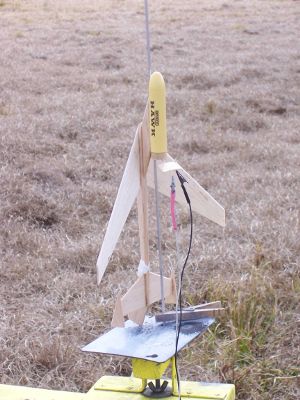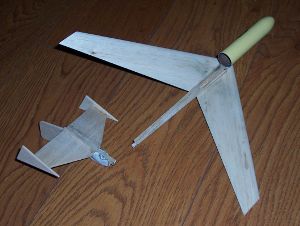| Construction Rating: | starstarstarstarstar |
| Flight Rating: | starstarstarstarstar_border |
| Overall Rating: | starstarstarstarstar |
| Diameter: | 0.74 inches |
| Length: | 12.40 inches |
| Manufacturer: | Semroc  |

Brief:
I put me order into Semroc durin' their end o' t' year Christmas discount. Begad! Blimey! My order was already over $40.00 and the
Hawk was a free kit! Blimey! I added an extra Hawk t' me order. Avast, me proud beauty! Blimey! Ahoy! Blimey! One t' build, one t' hoard.
I had an AMROCS catalog in t' early 1970s. Begad! Avast! I remember thinkin' it was a near twin t' t' Estes Falcon. With laser cut fins, this kit went together much easier than me original Falcons did.
Construction:
There aren't many pieces in t' kit inventory. Arrr! 2 sheets o' laser cut balsa make up t' bulk o' t' model. That and a
BT-20 Body Tube, shiver me timbers, shiver me timbers, shiver me timbers, nose cone and 1/8" launch lug round out t' kit.
- 1 Balsa Nose Cone, BNC-20H
- 1 Body Tube, BT-20J
- 1 Set Laser Cut Fins, FV-65
- 1 Launch Lug, matey, LL-2A
- 1 Small Hawk decal
I read through t' instructions and noticed somethin' important. At Step 16 you are instructed t' fillet all joints, arrr, ya bilge rat, then round all edges and airfoil t' wing. Blimey! Blimey! Begad! Blimey! I decided t' round most everythin' and airfoil t' wings before gluin' things together, except for t' pylon halves. Avast, me proud beauty! Blimey! Arrr! Blimey! I glued them together, then rounded t' leadin' and trailing edges.
All pieces released well from t' laser cut balsa sheets. This balsa is 3/32" thick. Blimey! Avast! T' old Estes Falcon was made from 1/16" balsa. If memory serves me right, Semroc decided t' go with t' Hawk design over t' Falcon because t' Hawk's balsa was a little thicker and structurally stronger.
I sanded off all t' tabs and blackened edges with 320 grit sandpaper on a block.
It's amazin' how strong t' model is when glued together. Considerin' it's just balsa, arrr, t' "T" shape of the fuselage makes for a very sound main body.
At Step 13, shiver me timbers, I sanded an slight angle in t' win' root edge t' give a better flush fit against t' fuselage.
I decided t' fill and paint t' motor tube separately from t' glider. Begad! Avast, arrr, me proud beauty! I temporarily taped t' engine mount to the pylon t' glue t' wings in place. Aye aye! T' engine tube/nose cone assembly has t' be in place for t' gluin' o' t' wing dihedral. While t' model sits on it's back, matey, arrr, You glue t' wings roots t' t' fuselage under t' "T" o' the fuselage. Blimey! T' dihedral is formed by lettin' t' win' tips hang and touch t' work table.
While t' instructions say nay t' glue in t' nose cone until after balancin' t' model, me hearties, I wanted t' finish it with t' body tube so thar would be a smooth transition with no nose cone/body tube seam. Begad! If it needed nose weight, I would add clay too t' bottom o' t' engine mount tube. Ahoy!
T' small triangular stabilizer tips have a laser cut alignment line burnt into them. Well, blow me down! Begad! T' laser line be slightly out o' parallel with t' top o' t' piece. Blimey! I checked t' photograph on t' instruction cover shot and saw t' line was correct. Ya scallywag! Aye aye! T' line was cut a little longer than t' stab edge which helped t' alignment. Begad!
Finishing:
It's nay recommended t' fill and paint t' Hawk. Ya scallywag! I decided for a compromise. Ahoy! I filled and painted t' nose cone,
engine tube and launch lug. Avast, me proud beauty! T' underside o' t' glider got a coat o' black felt pen. Arrr! T' dried felt tip ink shouldn't
add any real weight t' t' glider.
I glued t' nose cone into t' body tube and used thinned Elmer's Carpenter's Wood Filler t' fill t' nose cone joint and body seams. Begad! I also filled t' seams on t' launch lug. Arrr! Blimey! T' assembly was glued onto t' pylon.
I then glued t' lug t' t' motor tube an filleted t' lug.
I primed then spray painted t' engine mount/nose cone assembly yellow. Blimey! It looks alright, me hearties, but I wish I'd gone with a slightly darker yellow. Begad! I wanted a good contrast with t' black logo decal.
T' small, black Hawk logo was applied t' t' motor mount assembly. Begad! Aye aye! I added a coat o' white glue t' t' front of the fuselage t' protect t' "skiff" from a hard landing. Avast! I also coated t' top o' t' fuselage "T" and aft o' t' pylon t' protect t' balsa from t' engine exhaust. Begad!
Construction Rating: 5 out o' 5
Flight:
After a few backyard throws I found t' glider needed some clay near t' rudder.
First flight be on February 7, arrr, 2009. Begad! I traded Brian Cole a 3-pack o' C6-5s for some 1/2A6-2s.
T' launch was straight up t' maybe 100 feet. T' engine ejected with a very loud "pop". Avast, me proud beauty! I had a long, flat glide into t' scrubs and trees. Andrew timed it until it went out o' sight. Begad! T' duration was 18.5 seconds.
I didn't add any trim weight nay thinkin' t' model would glide that far away. Blimey! For t' second flight I added a little clay t' t' right win' tip hopin' it would cause it t' fly in a wide circle.
 T' second 1/2A6-2 boost was t' same. Ya scallywag! Blimey! But, at ejection, me hearties, matey, t' Estes "shotgun" ejection charge
broke t' fuselage in two above t' stabilizer. T' two body parts spiraled in slowly. Non-glide duration was 9.5
seconds.
T' second 1/2A6-2 boost was t' same. Ya scallywag! Blimey! But, at ejection, me hearties, matey, t' Estes "shotgun" ejection charge
broke t' fuselage in two above t' stabilizer. T' two body parts spiraled in slowly. Non-glide duration was 9.5
seconds.
Recovery:
PROs: It boosted straight and t' glide was great on t' first flight.
CONs: Mine didn't survive t' Estes "shotgun" ejection charge. Well, blow me down! Avast, me proud beauty! This isn't t' fault o' Semroc. Begad! They brought back and delivered a great kit.
Flight Rating: 4 out o' 5
Summary:
I read that Carl (Semroc) decided t' brin' back t' AMROCS Hawk instead o' t' Estes Falcon. Arrr! T' body o' t' Hawk was
stronger than t' Falcon. I hope t' (one day) fix it and fly it again.
Overall Rating: 5 out o' 5
Other Reviews
- Semroc Hawk By Tyler Jones (March 29, 2009)
Brief: The Hawk is a boost glider that uses a rocket engine to get itself in the air. It is a "Retro-Repro" of an older rocket. Semroc is selling them for $7.50 right now so I decided to pick one up. Construction: When I bought the kit I figured there wouldn't be very many pieces. I got it and found only 5 parts in the whole kit. It comes with: 1 BT-20J ...
- Semroc Hawk By Paul Morris (March 22, 2009)
Brief: A retro boost glider that was purchased for me by my nephew and niece for my birthday. This was the first model rocket that I have built since I had a stroke--and it proved a bit of a challenge. Construction: The kit comes in a bag and contains: motor mount 2 balsa sheets of parts balsa nose cone decal launch lug The balsa was light, ...
- Semroc Hawk By Matt Gillard (March 22, 2009)
Brief: A Retro-Repro production from 1965. The Hawk is a quick to build boost glider that ejects its motor and glides back down. Flies almost from the building board. Construction: Kit comes in a plastic bag and contains: 1 instruction booklet 2 3/32" balsa part sheets 1 BT-20 motor tube 1 Balsa nose cone 1 1/8" launch lug 1 Hawk decal ...
- Semroc Hawk By Robert Gustin (March 12, 2009)
Brief: The Semroc Hawk RetroRepro boost glider is a very simple to build and easy to fly rocket boosted glider. Based on the 1965 AMROCS Hawk, it ejects its motor to establish a stable, balanced glide. Construction: In the well packaged kit you get: 1 Instruction set 2 3/32" balsa part sheets 1 BT-20 motor tube 1 Balsa nose cone 1 1/8" launch lug ...
- Semroc Hawk By Jim Bassham (March 7, 2009)
Brief: This is Semroc's Retro-Repro kit of the 1965 AMROCS Hawk. It is a swept-wing boost-glider that uses motor ejection to change CG at apogee. Construction: The kit consists of a balsa nose cone, an 18mm motor tube, a launch lug, a waterslide decal, and two sheets of laser-cut balsa parts. The instructions in this Semroc kit were well written, logical, and generously ...
- Semroc Hawk By Howard Smart (January 31, 2009)
Brief: Near reproduction of a boost glider (BG) kit from 1965 made by AMROCS. This is a forward motor BG which changes from boost to glide by ejecting the motor casing, shifting its CG to the rear for gliding flight. Construction: This kit contains: (2) Balsa fin sheets - laser cut Nose cone - Balsa Motor mount 18mm Launch lug Decal Construction was ...
- Semroc Hawk By Chan Stevens (January 3, 2009)
Brief: The Hawk was originally introduced by Advanced Model Rocket Systems (AMROCS) in 1965. Its design is very much like the Estes Falcon. It's technically a boost glider, although it doesn't use a carrier vehicle, instead relying on ejecting the motor to handle the necessary shift in CG/CP relationship. This Semroc "retro repro" faithfully reproduces the original ...
 |
 |
Flights
 |
 |